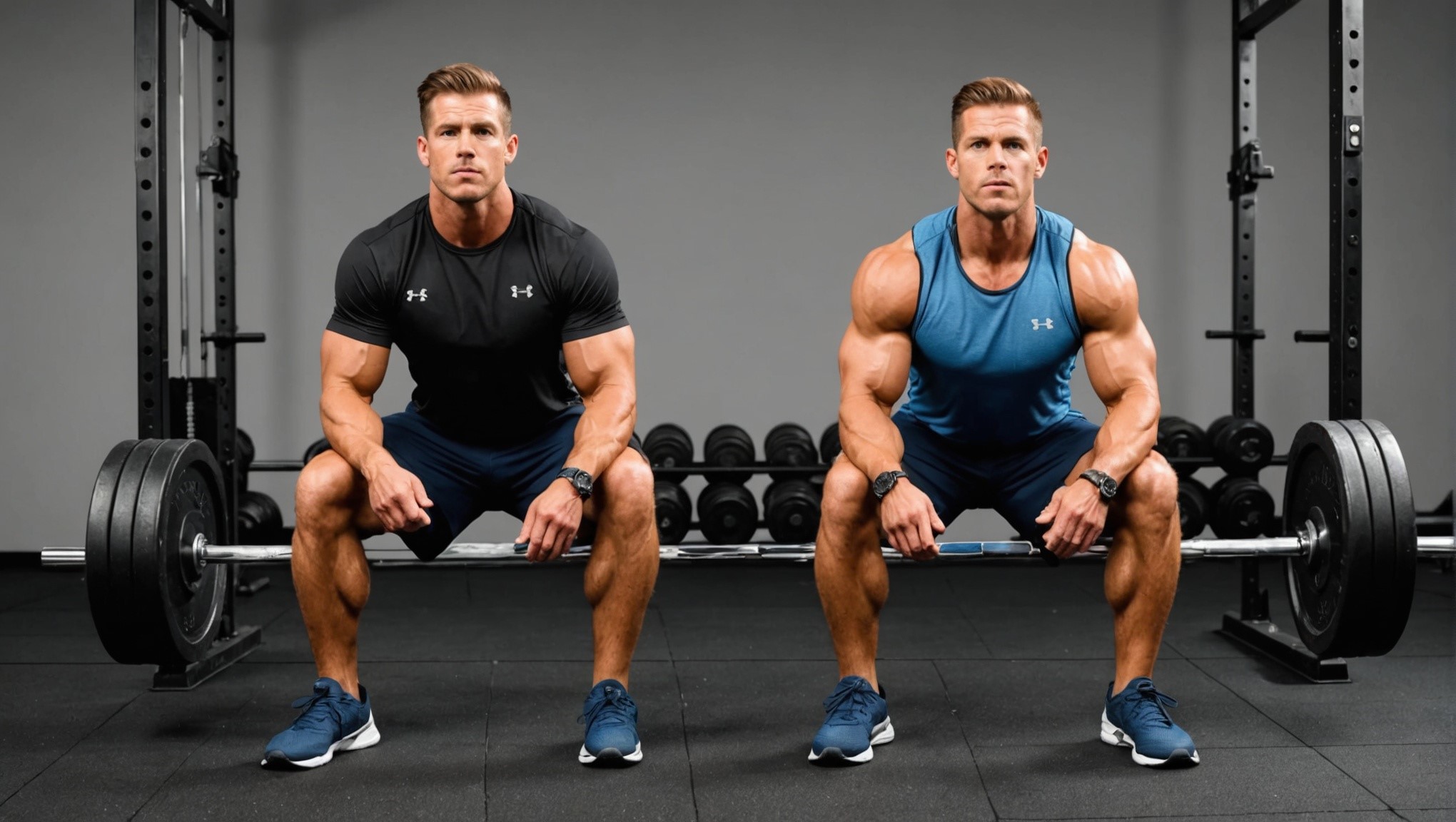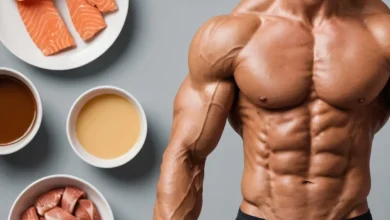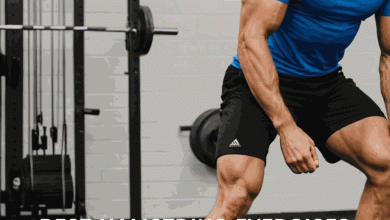Ranking Quad Exercises: The Best and Worst for Muscle Growth

Chapter 1: Introduction
In this video, we’ll be ranking 20 of the most popular quad exercises on a tier list, from S for super to F for fail. At the end, we’ll crown one exercise as the best of the best and one as the worst of the worst.
Chapter 2: What Are the Four Heads of the Quadriceps?
Before we dive into the rankings, let’s briefly understand the four heads of the quadriceps: the vastus medialis (teardrop muscle on the inside), vastus intermedius (middle), vastus lateralis (outside), and rectus femoris (long, flat head that runs down the middle).
Chapter 3: Ranking Quad Exercises on a Tier List from S to F
To make it into the top tier, an exercise needs to tick three boxes. First, it should provide high tension on the quads, especially in the stretched position. Second, it needs to feel good without causing knee pain and with a smooth resistance profile. Third, it should have a simple progression, allowing for progressive overload.
Chapter 4: The Worst Quad Exercises
Let’s start by identifying the exercises that don’t make the cut. Squat combination exercises like the squat plus press and the lunge plus curl are going straight to F tier. Their focus is on the upper body, not the quads. Bosu ball squats, due to their instability, limit quad tension and are also put in the F tier.
Chapter 5: The Best Quad Exercises
Now, let’s move on to the best quad exercises. We’ll start with the barbell back squat, which offers high tension, feels good, and allows for progressive overload. Powerlifters with massive quads can attest to their effectiveness.
Chapter 6: The Barbell Front Squat
The barbell front squat has all the same benefits as the back squat but shifts even more tension to the quads. Although it may be challenging for the upper back, it still deserves a spot in the S tier.
Chapter 7: The Low Bar Back Squat
The low bar back squat shifts tension from the quads to the glutes. While still activating the quads, it falls into the A tier due to the decreased emphasis on quad growth.
Chapter 8: The Hack Squat
The hack squat, a bodybuilding staple, checks all the boxes for an effective quad exercise. It offers high tension, feels good, and allows for easy progression, making it an S-tier exercise.
Chapter 9: The Pendulum Squat
Similar to the hack squat, the pendulum squat provides a natural resistance path, making it feel even better. Although not widely available in all gyms, it still earns its place in the S tier.
Chapter 10: The Smith Machine Squat
The Smith machine squat is gaining acceptance among bodybuilders, as it allows for close-to-failure quad stimulation without the fear of instability. It closely mimics the free weight barbell squat and deserves a spot in the S tier.
Chapter 11: The 45 Leg Press
The 45 leg press offers high tension on the quads, but some models limit the depth of the exercise compared to squats. Nonetheless, they generally feel good and allow for overload, earning them a spot in the A tier.
Chapter 12: The Horizontal Leg Press
The horizontal leg press, with its limited range of motion, is less effective than the 45 leg press. While it can still be useful for beginners, intermediate to advanced lifters may find it less effective. It falls into the C tier.
Chapter 13: The Lunge
Lunges are better for glute growth than quad growth. While they provide some tension and stretch on the quads, their focus is primarily on the glutes. Therefore, they belong in the B tier for quad exercises.
Chapter 14: The Leg Extension
The leg extension is a controversial exercise, with some claiming it’s bad for the knees. However, studies show that when performed correctly, it effectively engages all four heads of the quads. It belongs in the A tier, although it may not provide the same long-term quad gains as squats.
Chapter 15: The Reverse Nordic
The reverse Nordic, similar to the leg extension, provides a deep stretch on the quads. While it can be challenging for beginners and harder to overload, it earns its spot in the A tier due to its accessibility and stretch benefits.
Chapter 16: The Goblet Squat
Goblet squats are biomechanically similar to barbell front squats, but they are limited in terms of overload potential. They find their place in the B tier, suitable for teaching beginners and as a high-rep finisher exercise.
Chapter 17: The Jump Squat
Jump squats provide calorie burning and improve explosive power but are not ideal for muscle growth. For hypertrophy, there are better options available. They belong in the F tier for quad exercises.
Chapter 18: The Bulgarian Split Squat
Bulgarian split squats are highly effective but also fatiguing. They provide a significant stretch on the quads and help prevent muscle imbalances. Due to their effectiveness, they are placed in the S tier.
Chapter 19: The Deadlift
The deadlift activates the quads, but not to the same extent as squats. While they are excellent for overall strength and glute building, they fall into the C tier for quad exercises.
Chapter 20: The Step-Up
Step-ups offer some glute stimulus, but the limited quad stretch and stability make them less effective. They may have their place in some workouts, but they fall into the C tier overall.
Chapter 21: The Pistol Squat
Pistol squats are impressive but lack stability and overload potential. While they may be suitable for at-home workouts, there are better options available in a gym setting. They belong in the C tier.
Chapter 22: The Valslide Reverse Lunge
The Valslide reverse lunge allows for a deep stretch on the quads. However, it is not widely embraced due to its awkwardness. It earns a place in the A tier overall but may be a tier lower for some individuals.
Chapter 23: The Best Quad Exercise: Hack Squat
Now, let’s crown the best quad exercise: the hack squat. It provides high tension, feels good, and allows for easy progression. If the hack squat is not available, the high bar barbell back squat is a worthy alternative.
Chapter 24: The Worst Quad Exercise: Bosu Ball Squat
On the other hand, the worst quad exercise is the Bosu ball squat. Its instability limits quad tension, making it ineffective for muscle growth. It’s best to avoid this exercise altogether.
Chapter 25: Conclusion and Next Steps
Building strong quads requires a strategic approach to exercise selection. By incorporating the best quad exercises and avoiding the worst, you can maximize your muscle growth potential. Remember, proper form, progressive overload, and consistency are key. Stay dedicated, and you’ll achieve the quad gains you desire.
Remember, there’s much more to learn about triceps exercises. Check out the companion video on triceps training to level up your arm game!
Thanks for reading! If you enjoyed this post, don’t forget to give it a thumbs up, subscribe for more content, and stay tuned for the next one!
2024-11-13 23:27:02,594 – INFO – — Step 3: Generating Title — 2024-11-13 23:27:02,596 – INFO – Story Title: Ranking Quad Exercises: The Best and Worst for Muscle Growth 2024-11-13 23:27:02,596 – INFO – — Step 4: Generating Image — 2024-11-13 23:27:32,318 – INFO – Image URL: None 2024-11-13 23:27:32,318 – INFO – — Step 5: HTML Formatting — 2024-11-13 23:27:32,318 – INFO – HTML Formatted Article:
Ranking Quad Exercises: The Best and Worst for Muscle Growth
Chapter 1: Introduction
In this video, we’ll be ranking 20 of the most popular quad exercises on a tier list, from S for super to F for fail. At the end, we’ll crown one exercise as the best of the best and one as the worst of the worst.
Chapter 2: What Are the Four Heads of the Quadriceps?
Before we dive into the rankings, let’s briefly understand the four heads of the quadriceps: the vastus medialis (teardrop muscle on the inside), vastus intermedius (middle), vastus lateralis (outside), and rectus femoris (long, flat head that runs down the middle).
Chapter 3: Ranking Quad Exercises on a Tier List from S to F
To make it into the top tier, an exercise needs to tick three boxes. First, it should provide high tension on the quads, especially in the stretched position. Second, it needs to feel good without causing knee pain and with a smooth resistance profile. Third, it should have a simple progression, allowing for progressive overload.
Chapter 4: The Worst Quad Exercises
Let’s start by identifying the exercises that don’t make the cut. Squat combination exercises like the squat plus press and the lunge plus curl are going straight to F tier. Their focus is on the upper body, not the quads. Bosu ball squats, due to their instability, limit quad tension and are also put in the F tier.
Chapter 5: The Best Quad Exercises
Now, let’s move on to the best quad exercises. We’ll start with the barbell back squat, which offers high tension, feels good, and allows for progressive overload. Powerlifters with massive quads can attest to their effectiveness.
Chapter 6: The Barbell Front Squat
The barbell front squat has all the same benefits as the back squat but shifts even more tension to the quads. Although it may be challenging for the upper back, it still deserves a spot in the S tier.
Chapter 7: The Low Bar Back Squat
The low bar back squat shifts tension from the quads to the glutes. While still activating the quads, it falls into the A tier due to the decreased emphasis on quad growth.
Chapter 8: The Hack Squat
The hack squat, a bodybuilding staple, checks all the boxes for an effective quad exercise. It offers high tension, feels good, and allows for easy progression, making it an S-tier exercise.
Chapter 9: The Pendulum Squat
Similar to the hack squat, the pendulum squat provides a natural resistance path, making it feel even better. Although not widely available in all gyms, it still earns its place in the S tier.
Chapter 10: The Smith Machine Squat
The Smith machine squat is gaining acceptance among bodybuilders, as it allows for close-to-failure quad stimulation without the fear of instability. It closely mimics the free weight barbell squat and deserves a spot in the S tier.
Chapter 11: The 45 Leg Press
The 45 leg press offers high tension on the quads, but some models limit the depth of the exercise compared to squats. Nonetheless, they generally feel good and allow for overload, earning them a spot in the A tier.
Chapter 12: The Horizontal Leg Press
The horizontal leg press, with its limited range of motion, is less effective than the 45 leg press. While it can still be useful for beginners, intermediate to advanced lifters may find it less effective. It falls into the C tier.
Chapter 13: The Lunge
Lunges are better for glute growth than quad growth. While they provide some tension and stretch on the quads, their focus is primarily on the glutes. Therefore, they belong in the B tier for quad exercises.
Chapter 14: The Leg Extension
The leg extension is a controversial exercise, with some claiming it’s bad for the knees. However, studies show that when performed correctly, it effectively engages all four heads of the quads. It belongs in the A tier, although it may not provide the same long-term quad gains as squats.
Chapter 15: The Reverse Nordic
The reverse Nordic, similar to the leg extension, provides a deep stretch on the quads. While it can be challenging for beginners and harder to overload, it earns its spot in the A tier due to its accessibility and stretch benefits.
Chapter 16: The Goblet Squat
Goblet squats are biomechanically similar to barbell front squats, but they are limited in terms of overload potential. They find their place in the B tier, suitable for teaching beginners and as a high-rep finisher exercise.
Chapter 17: The Jump Squat
Jump squats provide calorie burning and improve explosive power but are not ideal for muscle growth. For hypertrophy, there are better options available. They belong in the F tier for quad exercises.
Chapter 18: The Bulgarian Split Squat
Bulgarian split squats are highly effective but also fatiguing. They provide a significant stretch on the quads and help prevent muscle imbalances. Due to their effectiveness, they are placed in the S tier.
Chapter 19: The Deadlift
The deadlift activates the quads, but not to the same extent as squats. While they are excellent for overall strength and glute building, they fall into the C tier for quad exercises.
Chapter 20: The Step-Up
Step-ups offer some glute stimulus, but the limited quad stretch and stability make them less effective. They may have their place in some workouts, but they fall into the C tier overall.
Chapter 21: The Pistol Squat
Pistol squats are impressive but lack stability and overload potential. While they may be suitable for at-home workouts, there are better options available in a gym setting. They belong in the C tier.
Chapter 22: The Valslide Reverse Lunge
The Valslide reverse lunge allows for a deep stretch on the quads. However, it is not widely embraced due to its awkwardness. It earns a place in the A tier overall but may be a tier lower for some individuals.
Chapter 23: The Best Quad Exercise: Hack Squat
Now, let’s crown the best quad exercise: the hack squat. It provides high tension, feels good, and allows for easy progression. If the hack squat is not available, the high bar barbell back squat is a worthy alternative.
Chapter 24: The Worst Quad Exercise: Bosu Ball Squat
On the other hand, the worst quad exercise is the Bosu ball squat. Its instability limits quad tension, making it ineffective for muscle growth. It’s best to avoid this exercise altogether.
Chapter 25: Conclusion and Next Steps
Building strong quads requires a strategic approach to exercise selection. By incorporating the best quad exercises and avoiding the worst, you can maximize your muscle growth potential. Remember, proper form, progressive overload, and consistency are key. Stay dedicated, and you’ll achieve the quad gains you desire.
Remember, there’s much more to learn about triceps exercises. Check out the companion video on triceps training to level up your arm game!
Thanks for reading! If you enjoyed this post, don’t forget to give it a thumbs up, subscribe for more content, and stay tuned for the next one!

